Sloth
| Sloths Early Oligocene to Holocene
| |
|---|---|
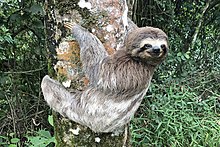
| |
Bradypus variegatus, a three-toed sloth
| |
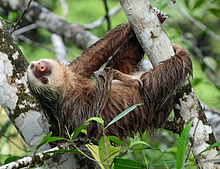
| |
Choloepus hoffmanni, a two-toed sloth
| |
| Scientific classification | |
| Domain: | Eukaryota |
| Kingdom: | Animalia |
| Phylum: | Chordata |
| Class: | Mammalia |
| Superorder: | Xenarthra |
| Order: | Pilosa |
| Suborder: | Folivora Delsuc, Catzeflis, Stanhope, and Douzery, 2001[2] |
| Families | |
| |

| |
| Red: two-toed sloth,Blue: three-toed sloth,Purple: both two-toed sloth and three-toed sloth | |
| Synonyms | |
| |
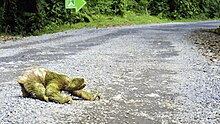
Sloths are a Neotropical group of xenarthran mammals constituting the suborder Folivora, including the extant arboreal tree sloths and extinct terrestrial ground sloths. Noted for their slowness of movement, tree sloths spend most of their lives hanging upside down in the trees of the tropical rainforests of South America and Central America. Sloths are considered to be most closely related to anteaters, together making up the xenarthran order Pilosa.
There are six extant sloth species in two genera –
Sloths are so named because of their very low metabolism and deliberate movements. Sloth, related to slow, literally means "laziness," and their common names in several other languages (e.g. German: Faultier, French: paresseux, Spanish: perezoso, Romanian: leneș, Finnish: laiskiainen) also mean "lazy" or similar. Their slowness permits their low-energy diet of leaves and avoids detection by predatory hawks and cats that hunt by sight.[3] Sloths are almost helpless on the ground but are able to swim.[4] The shaggy coat has grooved hair that is host to symbiotic green algae which camouflage the animal in the trees and provide it nutrients. The algae also nourish sloth moths, some species of which exist solely on sloths.[5]
Taxonomy and evolution
Sloths belong to the superorder
The Folivora are divided into at least eight families, only two of which have living species; the remainder are entirely extinct (†):[8]
- †Megalocnidae: the Greater Antilles sloths, a basal group that arose about 32 million years ago and became extinct about 5,000 years ago.[8]
- Superfamily Megatherioidea
- Bradypodidae, the three-toed sloths, contains four extant species:
- The brown-throated three-toed sloth is the most common of the extant species of sloth, which inhabits the Neotropical realm[1][9] in the forests of South and Central America.
- The pale-throated three-toed sloth, which inhabits tropical rainforests in northern South America. It is similar in appearance to, and often confused with, the brown-throated three-toed sloth, which has a much wider distribution. Genetic evidence indicates the two species diverged around six million years ago.[10]
- The maned three-toed sloth, now found only in the Atlantic Forest of southeastern Brazil.
- The critically endangered endemic to the small island of Isla Escudo de Veraguas off the coast of Panama.
- †Megalonychidae: ground sloths that existed for about 35 million years and went extinct about 11,000 years ago. This group was formerly thought to include both the two-toed sloths and the extinct Greater Antilles sloths.
- †Megatheriidae: ground sloths that existed for about 23 million years and went extinct about 11,000 years ago; this family included the largest sloths.
- †Nothrotheriidae: ground sloths that lived from approximately 11.6 million to 11,000 years ago. As well as ground sloths, this family included Thalassocnus, a genus of either semiaquatic or fully aquatic sloths.
- Bradypodidae, the three-toed sloths, contains four extant species:
- Superfamily Mylodontoidea
- Choloepodidae, the two-toed sloths, contains two extant species:
- Linnaeus's two-toed sloth found in Venezuela, the Guianas, Colombia, Ecuador, Peru, and Brazil north of the Amazon River.
- Hoffmann's two-toed sloth which inhabits tropical forests. It has two separate ranges, split by the Andes. One population is found from eastern Honduras[11] in the north to western Ecuador in the south, and the other in eastern Peru, western Brazil, and northern Bolivia.[12]
- †Mylodontidae: ground sloths that existed for about 23 million years and went extinct about 11,000 years ago.
- †Choloepus is, so it has been elevated back to full family status.[8]
- Choloepodidae, the two-toed sloths, contains two extant species:
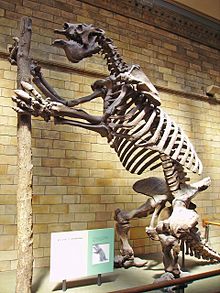
Evolution
The common ancestor of the two existing sloth genera dates to about 28 million years ago,
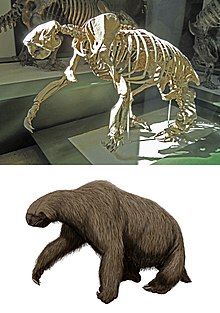

Sloths arose in South America during a long period of isolation and eventually spread to a number of the Caribbean islands as well as North America. It is thought that swimming led to oceanic dispersal of pilosans to the Greater Antilles by the Oligocene, and that the megalonychid Pliometanastes and the mylodontid Thinobadistes were able to colonise North America about 9 million years ago, well before the formation of the Isthmus of Panama. The latter development, about 3 million years ago, allowed megatheriids and nothrotheriids to also invade North America as part of the Great American Interchange. Additionally, the nothrotheriid Thalassocnus of the west coast of South America became adapted to a semiaquatic and, eventually, perhaps fully aquatic marine lifestyle.[14] In Peru and Chile, Thalassocnus entered the coastal habitat beginning in the late Miocene. They presumably waded and paddled in the water for short period, but over a span of 4 million years, they eventually evolved into swimming creatures, becoming specialist bottom feeders of seagrasses, similar to the extant sirenians.[15]
Both types of extant tree sloth tend to occupy the same forests; in most areas, a particular species of the somewhat smaller and generally slower-moving three-toed sloth (Bradypus) and a single species of the two-toed type will jointly predominate. Based on morphological comparisons, it was thought the two-toed sloths nested phylogenetically within one of the divisions of the extinct Greater Antilles sloths.[16] Though data has been collected on over 33 different species of sloths by analyzing bone structures, many of the relationships between clades on a phylogenetic tree were unclear.[17] Much of the morphological evidence collected to support the hypothesis of diphyly has been based on the structure of the inner ear.[18]
Recently obtained molecular data from
Phylogeny
The following sloth family phylogenetic tree is based on collagen and mitochondrial DNA sequence data.[8]
| Folivora |
| |||||||||||||||||||||||||||||||||||||||||
Extinctions
The marine sloths of South America's Pacific coast became extinct at the end of the Pliocene following the closing of the Central American Seaway; the closing caused a cooling trend in the coastal waters which killed off much of the area's seagrass (and which would have also made thermoregulation difficult for the sloths, with their slow metabolism).[20]
Ground sloths disappeared from both North and South America shortly after the appearance of humans about 11,000 years ago. Evidence suggests human hunting contributed to the extinction of the American megafauna. Ground sloth remains found in both North and South America indicate that they were killed, cooked, and eaten by humans.[4] Climate change that came with the end of the last ice age may have also played a role, although previous similar glacial retreats were not associated with similar extinction rates.
Megalocnus and some other Caribbean sloths survived until about 5,000 years ago, long after ground sloths had died out on the mainland, but then went extinct when humans finally colonized the Greater Antilles.[21]
Biology
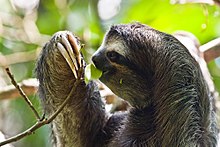
Morphology and anatomy
Sloths can be 60 to 80 cm (24 to 31 in) long and, depending on the species, weigh from 3.6 to 7.7 kg (7.9 to 17.0 lb). Two-toed sloths are slightly larger than three-toed sloths.[22] Sloths have long limbs and rounded heads with tiny ears. Three-toed sloths also have stubby tails about 5 to 6 cm (2.0 to 2.4 in) long.
Sloths are unusual among mammals in not having seven cervical vertebrae. Two-toed sloths have five to seven, while three-toed sloths have eight or nine. The other mammals not having seven are the manatees, with six.[23]
Physiology
Sloths have colour vision but have poor visual acuity. They also have poor hearing. Thus, they rely on their sense of smell and touch to find food.[24]
Sloths have very low
The outer hairs of sloth fur grow in a direction opposite from that of other mammals. In most mammals, hairs grow toward the extremities, but because sloths spend so much time with their limbs above their bodies, their hairs grow away from the extremities to provide protection from the elements while they hang upside down. In most conditions, the fur hosts symbiotic algae, which provide camouflage[25] from predatory jaguars, ocelots,[26] and harpy eagles.[27] Because of the algae, sloth fur is a small ecosystem of its own, hosting many species of commensal and parasitic arthropods.[28] There are a large number of arthropods associated with sloths. These include biting and blood-sucking flies such as mosquitoes and sandflies, triatomine bugs, lice, ticks and mites. Sloths have a highly specific community of commensal beetles, mites and moths.[29] The species of sloths recorded to host arthropods include[29] the pale-throated three-toed sloth, the brown-throated three-toed sloth, and Linnaeus's two-toed sloth. Sloths benefit from their relationship with moths because the moths are responsible for fertilizing algae on the sloth, which provides them with nutrients.[30]
Activity
Their limbs are adapted for hanging and grasping, not for supporting their weight. Muscle mass makes up only 25 to 30 percent of their total body weight. Most other mammals have a muscle mass that makes up 40 to 45 percent of their total body weight.[31] Their specialised hands and feet have long, curved claws to allow them to hang upside down from branches without effort,[32] and are used to drag themselves along the ground, since they cannot walk. On three-toed sloths, the arms are 50 percent longer than the legs.[24]
Sloths move only when necessary and even then, very slowly. They usually move at an average speed of 4 metres (13 ft) per minute but can move at a marginally higher speed of 4.5 metres (15 ft) per minute if they are in immediate danger from a predator. While they sometimes sit on top of branches, they usually eat, sleep, and even give birth hanging from branches. They sometimes remain hanging from branches even after death. On the ground, the maximum speed of sloths is 3 metres (9.8 ft) per minute. Two-toed sloths are generally better able than three-toed sloths to disperse between clumps of trees on the ground.[33]
Sloths are surprisingly strong swimmers and can reach speeds of 13.5 metres (44 ft) per minute.[34] They use their long arms to paddle through the water and can cross rivers and swim between islands.[35] Sloths can reduce their already slow metabolism even further and slow their heart rate to less than a third of normal, allowing them to hold their breath underwater for up to 40 minutes.[36]
Wild brown-throated three-toed sloths sleep on average 9.6 hours a day.
Behavior
Sloths are solitary animals that rarely interact with one another except during breeding season,[39] though female sloths do sometimes congregate, more so than do males.[40]
Sloths descend about once every eight days to defecate on the ground. The reason and mechanism behind this behavior have long been debated among scientists. There are at least five hypotheses: 1) fertilize trees when feces are deposited at the base of the tree;[41] 2) cover feces and avoid predation;[42][43][44] 3) chemical communication between individuals;[45] 4) pick up trace nutrients in their claws, that are then ingested;[46] and 5) favor a mutualistic relationship with populations of fur moths.[44][46] More recently, a new hypothesis has emerged, which presents evidence against the previous ones and proposes that all current sloths are descendants from species that defecated on the ground, and there simply has not been enough selective pressure to abandon this behavior, since cases of predation during defecation are actually very rare.[47]
Diet
Baby sloths learn what to eat by licking the lips of their mother.[48] All sloths eat the leaves of Cecropia
Two-toed sloths are
They have made adaptations to
Three-toed sloths go to the ground to urinate and defecate about once a week, digging a hole and covering it afterwards. They go to the same spot each time and are vulnerable to predation while doing so. Considering the large energy expenditure and dangers involved in the journey to the ground, this behaviour has been described as a mystery.[49][50][51] Recent research shows that moths, which live in the sloth's fur, lay eggs in the sloth's feces. When they hatch, the larvae feed on the feces, and when mature fly up onto the sloth above. These moths may have a symbiotic relationship with sloths, as they live in the fur and promote growth of algae, which the sloths eat.[5] Individual sloths tend to spend the bulk of their time feeding on a single "modal" tree; by burying their excreta near the trunk of that tree, they may also help nourish it.[52]
Reproduction
The pale- and brown-throated three-toed sloths mate seasonally, while the maned three-toed sloth breeds at any time of the year. The reproduction of pygmy three-toed sloths is currently unknown. Litters are of one newborn only, after six months' gestation for three-toed, and 12 months for two-toed. Newborns stay with their mother for about five months. In some cases, young sloths die from a fall indirectly because the mothers prove unwilling to leave the safety of the trees to retrieve the young.[53] Females normally bear one baby every year, but sometimes sloths' low level of movement actually keeps females from finding males for longer than one year.[54] Sloths are not particularly sexually dimorphic and several zoos have received sloths of the wrong sex.[55][56]
The average lifespan of two-toed sloths in the wild is currently unknown due to a lack of full-lifespan studies in a natural environment.[57] Median life expectancy in human care is about 16 years, with one individual at the Smithsonian Institution's National Zoo reaching an age of 49 years before her death.[58]
Distribution
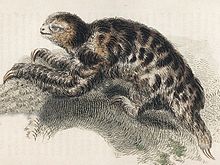
Although habitat is limited to the tropical rainforests of Central and South America, in that environment sloths are successful. On
Human relations
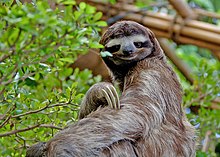
The majority of recorded sloth deaths in Costa Rica are due to contact with electrical lines and poachers. Their claws also provide another, unexpected deterrent to human hunters; when hanging upside-down in a tree, they are held in place by the claws themselves and often do not fall down even if shot from below.
Sloths are victims of animal trafficking where they are sold as pets. However, they make very poor pets, as they have such a specialized ecology.[62]
The Sloth Institute Costa Rica is known for caring, rehabilitating and releasing sloths back into the wild.[63] Also in Costa Rica, the Aviarios Sloth Sanctuary cares for sloths. It has rehabilitated and returned about 130 individuals to the wild.[64] However, a report in May 2016 featured two former veterinarians from the facility who were critical of the sanctuary's efforts, accusing it of mistreating the animals.[65]
References
- ^ OCLC 62265494.
- ^ PMID 11487408.
- ^ a b "Overview". The Sloth Conservation Foundation. Archived from the original on 1 December 2017. Retrieved 29 November 2017.
- ^ a b c The Land and Wildlife of South America. Time Inc. 1964. pp. 15, 54.
- ^ a b Bennington-Castro, Joseph (23 January 2014). "The Strange Symbiosis Between Sloths and Moths". Gizmodo. Archived from the original on 1 December 2017. Retrieved 1 December 2017.
- S2CID 206544776.
- PMID 16848642.
- ^ (PDF) from the original on 12 September 2020. Retrieved 18 September 2020.
- ISBN 978-0-226-28240-4. Archived from the originalon 27 November 2018. Retrieved 29 November 2017.
- .
- .
- doi:10.1644/873.1.
- ISSN 0024-4082.
- S2CID 83859607.
- PMID 24621950.
- ISBN 978-0-8493-2001-9. Archivedfrom the original on 24 May 2021. Retrieved 9 June 2020.
- .
- PMID 25319928.
- ^ from the original on 23 March 2022. Retrieved 11 June 2020.
- S2CID 16700349.
- PMID 16085711.
- ^ "Sloth". National Geographic. March 2014. Archived from the original on 11 April 2019. Retrieved 1 December 2017.
- ^ "Sticking their necks out for evolution: Why sloths and manatees have unusually long (or short) necks". ScienceDaily. Archived from the original on 26 April 2019. Retrieved 26 April 2019.
- ^ a b c d "Sloth". Encyclopedia Britannica. Archived from the original on 19 May 2017. Retrieved 1 December 2017.
- PMID 20353556.
- S2CID 37859321.
- S2CID 86270583.
- PMID 11151024.
- ^ (PDF) from the original on 6 November 2020. Retrieved 1 December 2017.
- ^ Ed Yong (21 January 2014). "Can Moths Explain Why Sloths Poo on the Ground?". Phenomena. Archived from the original on 29 May 2018. Retrieved 23 January 2014.
- ^ "What Does It Mean to Be a Sloth?". natureinstitute.org. Archived from the original on 15 June 2019. Retrieved 29 June 2017.
- JSTOR 1381249.
- .
- ^ Goffart, M. (1971). "Function and Form in the sloth". International Series of Monographs in Pure and Applied Biology. 34: 94–95.
- ^ BBC (4 November 2016), Swimming sloth - Planet Earth II: Islands Preview - BBC One, archived from the original on 30 October 2021, retrieved 17 April 2017
- S2CID 85162387.
- ^ Briggs, Helen (13 May 2008). "Article "Sloth's Lazy Image 'A Myth'"". BBC News. Archived from the original on 1 January 2021. Retrieved 21 May 2010.
- from the original on 19 September 2020. Retrieved 25 September 2016.
- ^ a b c Alina Bradford (26 November 2018). "Sloths: The World's Slowest Mammals". Live Science. Archived from the original on 4 December 2020. Retrieved 22 November 2020.
- ^ "Sloth". Animal Corner. Archived from the original on 8 November 2020. Retrieved 22 November 2020.
- ^ Montgomery, G. G., & Sunquist, M. E. (1975). Impact of Sloths on Neotropical Forest Energy Flow and Nutrient Cycling. Ecological Studies, 69–98. DOI:10.1007/978-3-642-88533-4_7
- ^ Bailey, T. N. (1974). Social organization in a bobcat population. The Journal of Wildlife Management, 38(3),435-446.
- ^ Liberg, O. (1980). Spacing patterns in a population of rural free roaming domestic cats. Oikos, 32(3),336-349.
- ^ a b Pauli, J. N., Mendoza, J. E., Steffan, S. A., Carey, C. C., Weimer, P. J., & Peery, M. Z. (2014). A syndrome of mutualism reinforces the lifestyle of a sloth. Proceedings of the Royal Society B: Biological Sciences, 281(1778), 20133006. DOI: 10.1098/rspb.2013.3006
- ^ Chiarello, A. G. (2008). Sloth ecology: an overview of field studies. The biology of the Xenarthra, 269-280.
- ^ a b Voirin, B., Kays, R., Wikelski, M., & Lowman, M. (2013). Why Do Sloths Poop on the Ground? In M. Lowman, S. Devy, & T. Ganesh (eds). Treetops at Risk(pp. 195-199). Springer, New York, NY.
- ^ Monge Nájera, J. (2021). Why sloths defecate on the ground: rejection of the mutualistic model. UNED Research Journal, 13(1), 4-4.
- ^ Venema, Vibeke (4 April 2014). "The woman who got 'slothified'". BBC News. Archived from the original on 6 March 2021. Retrieved 1 December 2017.
- ^ "The 'Busy' Life of the Sloth | BBC Earth". YouTube. 18 May 2009. Archived from the original on 16 February 2021. Retrieved 11 February 2022.
- ^ "The greatest mystery of sloth pooping has been solved". 23 January 2014. Archived from the original on 27 January 2021. Retrieved 9 February 2021.
- PMID 24452028.
- ^ Montgomery, Sy. "Community Ecology of the Sloth". Cecropia: Supplemental Information. Encyclopædia Britannica. Archived from the original on 24 May 2009. Retrieved 6 September 2009.
- PMID 12489397.
- PMID 23284687.
- ^ "Manly secret of non-mating sloth at London Zoo". BBC News. BBC. 19 August 2010. Archived from the original on 19 September 2020. Retrieved 30 April 2015.
- ^ "Same-sex sloths dash Drusillas breeding plan". BBC News. BBC. 5 December 2013. Archived from the original on 5 December 2020. Retrieved 30 April 2015.
- ^ "About the Sloth". Sloth Conservation Foundation. Archived from the original on 16 January 2021. Retrieved 31 October 2019.
- ^ "Southern two-toed sloth". Smithsonian's National Zoo. 25 April 2016. Archived from the original on 17 July 2019. Retrieved 30 October 2019.
- from the original on 19 September 2020. Retrieved 25 September 2016.
- .
- ^ Dowling, Stephen (29 August 2019). "Why do sloths move so slowly?". BBC Future. BBC News. Archived from the original on 12 September 2019. Retrieved 2 September 2019.
- ^ "Sloths: Hottest-Selling Animal in Colombia's Illegal Pet Trade". ABC News. 29 May 2013. Archived from the original on 6 July 2020. Retrieved 2 December 2017.
- ^ "The Sloth Institute website". Archived from the original on 31 March 2021. Retrieved 23 March 2022.
- ^ Sevcenko, Melanie (17 April 2013). "Sloth sanctuary nurtures animals back to health". Deutsche Welle. Archived from the original on 13 May 2015. Retrieved 18 April 2013.
- ^ Schelling, Ameena (19 May 2016). "Famous Sloth Sanctuary Is A Nightmare For Animals, Ex-Workers Say". The Dodo. Archived from the original on 18 January 2021. Retrieved 20 May 2016.
External links




